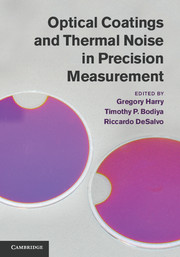Book contents
- Frontmatter
- Contents
- List of contributors
- Foreword
- Preface
- 1 Theory of thermal noise in optical mirrors
- 2 Coating technology
- 3 Compendium of thermal noises in optical mirrors
- 4 Coating thermal noise
- 5 Direct measurements of coating thermal noise
- 6 Methods of improving thermal noise
- 7 Substrate thermal noise
- 8 Cryogenics
- 9 Thermo-optic noise
- 10 Absorption and thermal issues
- 11 Optical scatter
- 12 Reflectivity and thickness optimization
- 13 Beam shaping
- 14 Gravitational wave detection
- 15 High-precision laser stabilization via optical cavities
- 16 Quantum optomechanics
- 17 Cavity quantum electrodynamics
- References
8 - Cryogenics
Published online by Cambridge University Press: 05 January 2012
- Frontmatter
- Contents
- List of contributors
- Foreword
- Preface
- 1 Theory of thermal noise in optical mirrors
- 2 Coating technology
- 3 Compendium of thermal noises in optical mirrors
- 4 Coating thermal noise
- 5 Direct measurements of coating thermal noise
- 6 Methods of improving thermal noise
- 7 Substrate thermal noise
- 8 Cryogenics
- 9 Thermo-optic noise
- 10 Absorption and thermal issues
- 11 Optical scatter
- 12 Reflectivity and thickness optimization
- 13 Beam shaping
- 14 Gravitational wave detection
- 15 High-precision laser stabilization via optical cavities
- 16 Quantum optomechanics
- 17 Cavity quantum electrodynamics
- References
Summary
Introduction
The use of cryogenic mirrors can be an attractive way of minimizing thermal noise due to optical coatings and substrates. As long as special care is taken in choosing materials, thermally induced fluctuations should be “frozen” at low temperatures. In this chapter, we introduce the current understanding of temperature dependence of mirror thermal noise, some practical design issues, and examples of cryogenic experiments.We will mainly focus on off-resonant thermal noise and physical cooling issues of macroscopic optics. For more on cooling of resonant thermal noise, see Chapter 16.
Temperature dependence of mirror thermal noise
In sensitive optical experiments, thermal fluctuations of coatings and substrates are important sources of noise and both tend to be reduced at cryogenic temperatures. The gains from cryogenics could come from several directions: the direct reduction of temperature itself, the decrease in mechanical losses (occurring in some materials), and the precipitous drop in specific heat and the increase in the mean free path of phonons. Appropriate materials and beam parameters must be adopted so that every kind of thermal noise is minimized by cryogenics simultaneously. Typically, Brownian thermal noise in coatings improves very slowly from cryogenics. This is due to a weak temperature dependence of mechanical loss. Coating thermal noise is also usually dominant over the substrate Brownian noise, so improvements of coating thermal noise directly impact measurement sensitivity. Substrate thermoelastic noise (see Chapter 7), coating thermo-optic noise (see Chapter 9), and other thermal noises (see Chapter 3) generally have less importance at cryogenic temperatures and at low frequencies.
- Type
- Chapter
- Information
- Optical Coatings and Thermal Noise in Precision Measurement , pp. 108 - 128Publisher: Cambridge University PressPrint publication year: 2012
- 1
- Cited by

